Lessico
Ciclamino
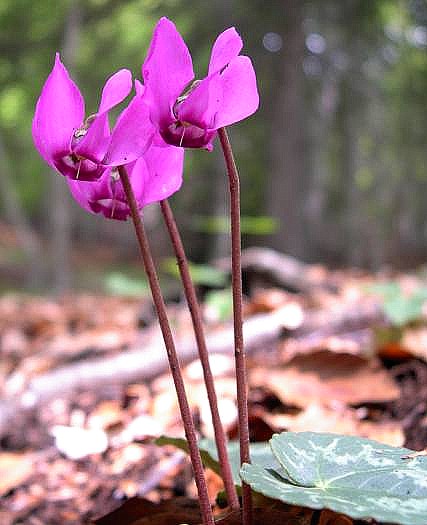
Cyclamen europaeum
Il termine deriva dal latino cyclaminos oppure cyclaminum, che risale al greco kykláminos. Nome generico di diverse specie di piante appartenenti al genere Cyclamen, della famiglia Primulaceae. Il ciclamino proviene dall'Europa, dall'Asia occidentale e dall'Africa settentrionale. In Italia crescono 3 specie allo stato spontaneo:
Cyclamen europaeum (=Cyclamen roseum), detto anche pan porcino, diffuso nell'Italia settentrionale, a fioritura estiva-autunnale
Cyclamen neapolitanum, della Liguria e dell'Italia centro-meridionale, che fiorisce anch'esso d'estate e in autunno
Cyclamen repandum, delle regioni meridionali e delle isole, che ha fioritura primaverile.
Sono erbacee munite di tuberi globosi o un po' compressi di color rosso violaceo, con poche radici, dai quali si innalzano diverse foglie tutte basali e lungamente picciolate, ovato-cuoriformi, denticolate o intere, spesso macchiate di bianco al di sopra e rossastre sulla pagina inferiore. I fiori sono solitari, basali e lungamente peduncolati anch'essi, regolari, con corolla a 5 petali saldati alla base e che si rovesciano all'insù dopo l'apertura, di color roseo-lilla e lievemente profumati. L'ovario è unico, supero, con un solo stilo. Il frutto è una capsula globosa divisa in 5 valve e portata sotterra dal peduncolo che si attorciglia a spirale dopo la fecondazione.
Il tubero fresco, contenente un glucoside (ciclamina), è mangiato senza danno dai maiali, che ne sono ghiotti, ma può provocare seri inconvenienti all'uomo se non cotto. Molto coltivato in vaso come ornamento per la ricca fioritura primaverile è Cyclamen persicum (ciclame), originario dell'Iran e dell'Asia Minore, che ha fiori più grandi di quelli delle specie selvatiche e dai colori che variano dal bianco al rosso al porporino.
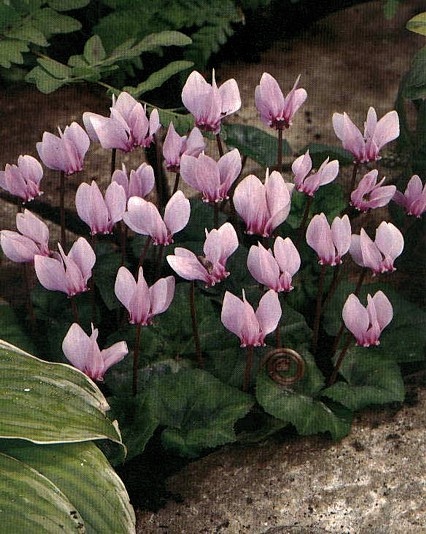
Cyclamen neapolitanum
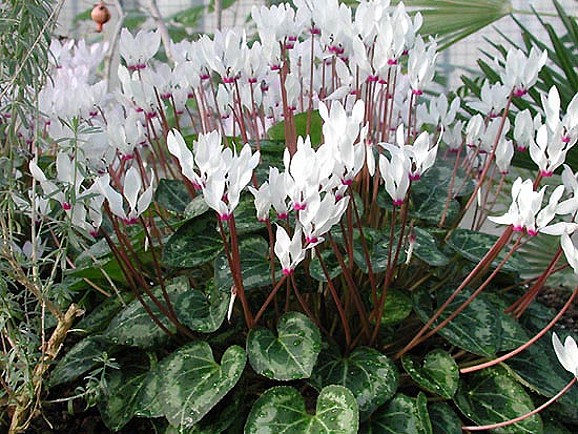
Cyclamen persicum
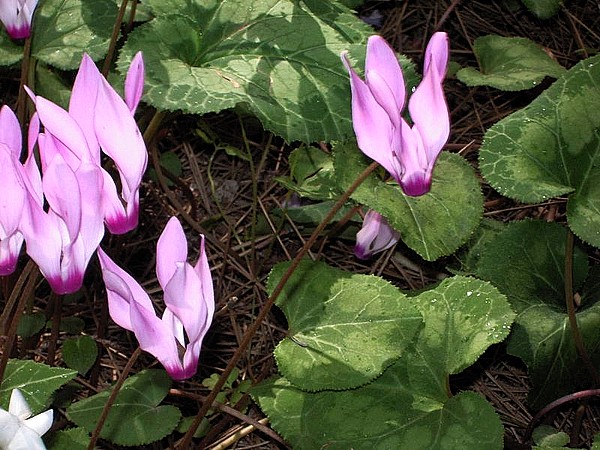
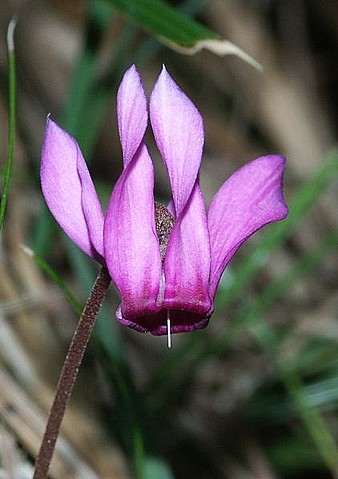
Cyclamen purpurascens
Cyclamen is a genus of 20 species of flowering plants, traditionally classified in the family Primulaceae, but in recent years reclassified in the family Myrsinaceae. The genus is most widely known by its scientific name cyclamen being taken into common usage; other names occasionally used include sowbread and sometimes, confusingly, persian violet (it is not related to the violets), or primrose (neither is it a primrose).
Cyclamen are native to the Mediterranean region from Spain east to Iran, and also in northeast Africa south to Somalia. They are perennial herbaceous aestivating plants, with a surface or underground tuber (derived from the hypocotyl) 4-12 cm diameter, which produces leaves in late winter, and flowers in the autumn; the leaves die down during the hottest part of the Mediterranean summer drought to conserve water.
The leaves are rounded to triangular, 2-10 cm long and 2-7 cm broad, and usually variegated with a pale silvery horseshoe-shaped mark round the middle of the leaf. The variegation is thought by some botanists to be a form of natural disruptive camouflage to reduce grazing damage by animals. The flowers are produced in whorls of 3-10, each flower on a slender stem 3-12 cm tall, with five united petals; the petals are usually reflexed back 90° to 180° erect above the flower, and vary from white through pink to red-purple, most commonly pale pink.
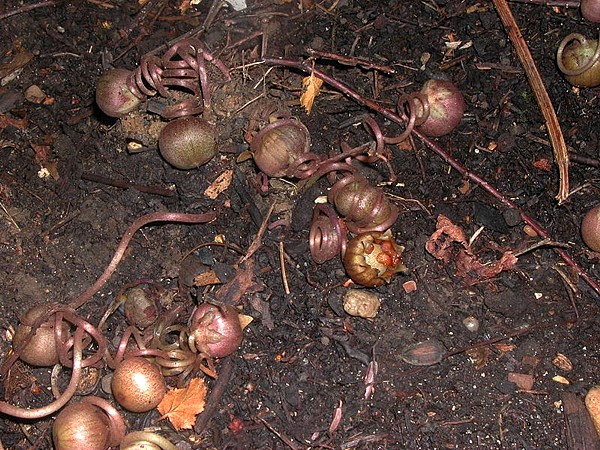
The fruit is a five-chambered capsule 1-2 cm diameter, containing numerous sticky seeds about 2 mm diameter. Natural seed dispersal is by ants, which eat the sticky covering and then discard the seeds. Cyclamens are used as food plants by the larvae of some Lepidoptera species including The Gothic.
Cyclamen typically grow in dry forest or scrub, where they are at least partly shaded from intense sunlight. The species vary greatly in winter frost tolerance, with the hardiest species (C. hederifolium) tolerating temperatures down to -15°C, or -30°C if covered by snow; others, such as C. somalense from northeastern Somalia, do not tolerate any frost at all. Climate change models suggest many species could become extinct in their current range within the next 50 years (Yesson & Culham 2006).
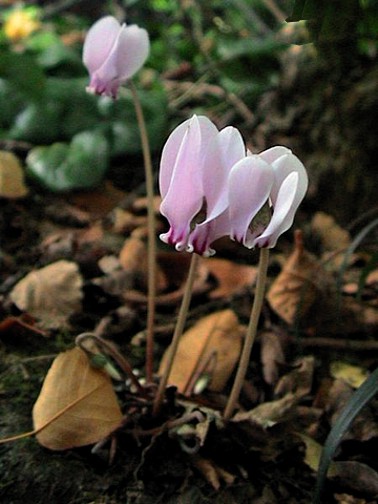
Cyclamen hederifolium
Cyclamen are commonly grown for their flowers, both outdoors and indoors in pots. Several species are hardy and can be grown outdoors in mild climates such as northwest Europe and the Pacific Northwest.
The cyclamen commonly sold by florists is Cyclamen persicum, which is frost-tender. Selected cyclamen cultivars can have white, bright pink, red or purple flowers. While flowering, florists' cyclamens should be kept below 68 °F (20 °C, 293 kelvins), with the night time temperatures preferably between 44 °F to 59 °F (6.67 °C to 15 °C, or 280 K to 288 K). Temperatures above 68 °F (20 °C, 293 K) may induce the plant to go dormant.
In many areas within the native range, cyclamen populations have been severely depleted by collection from the wild, often illegally, for the horticultural trade; some species are now endangered as a result. However, in a few areas, plant conservation charities have educated local people to control the harvest carefully at a sustainable level, including sowing seed for future crops, both sustaining the wild populations and producing a reliable long-term income. Many cyclamen are also propagated in nurseries without harm to the wild plants.
Cyclamen species are poisonous; they have been used medicinally as a powerful purgative, but their toxicity makes this risky.
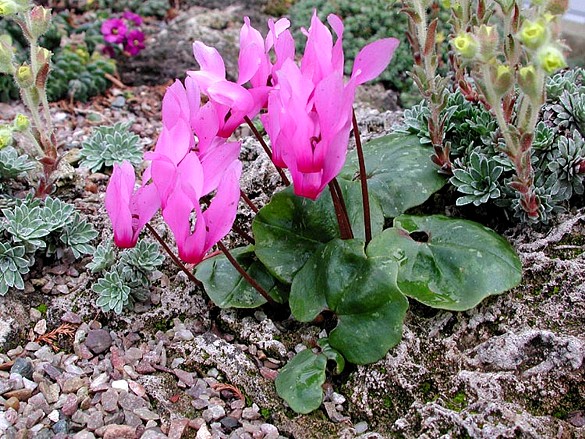
Cyclamen repandum